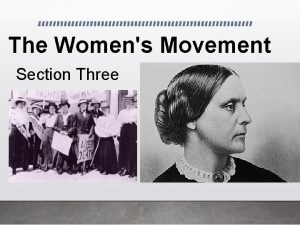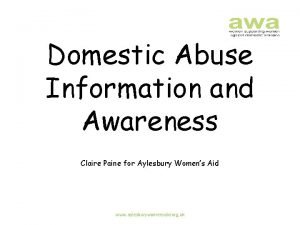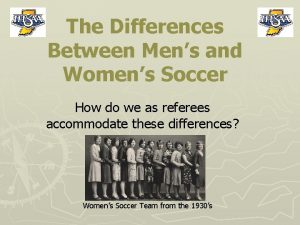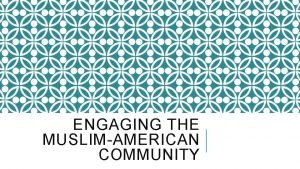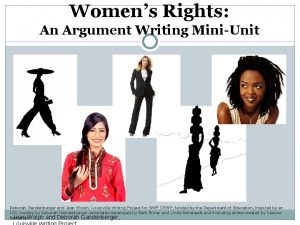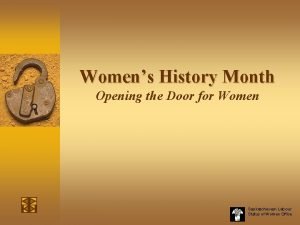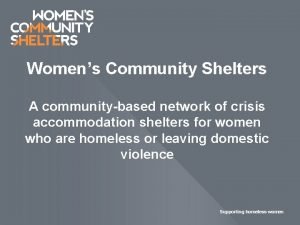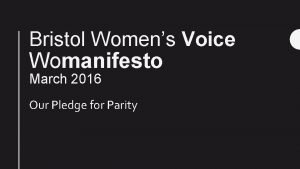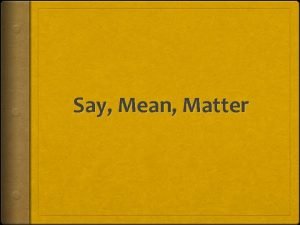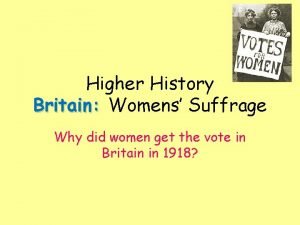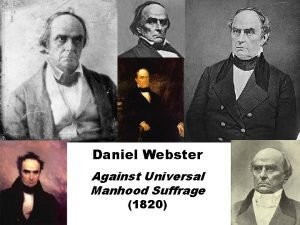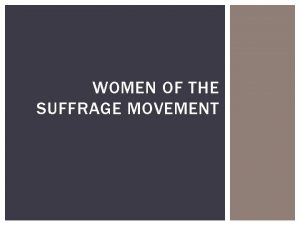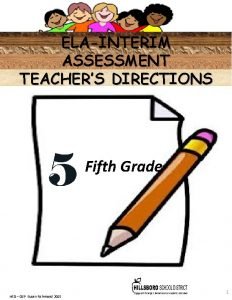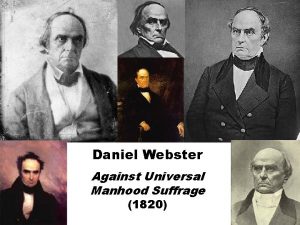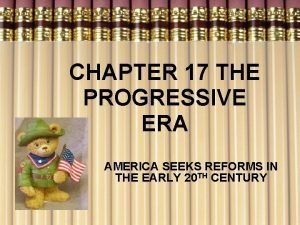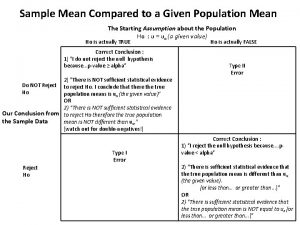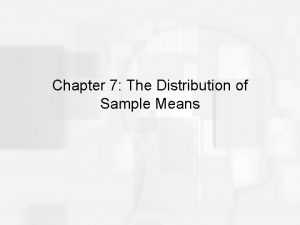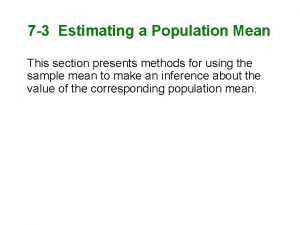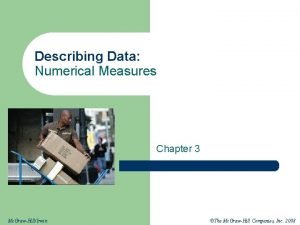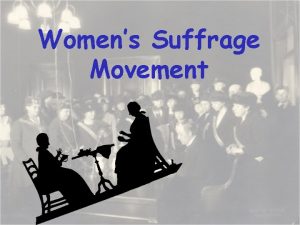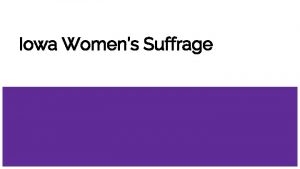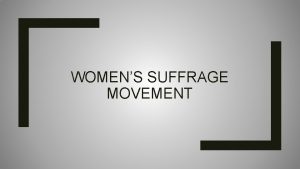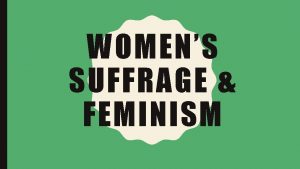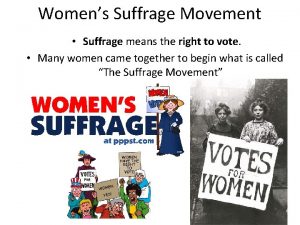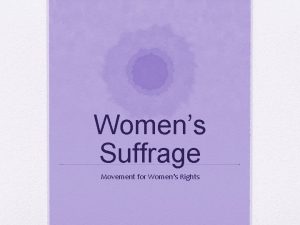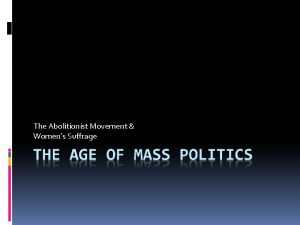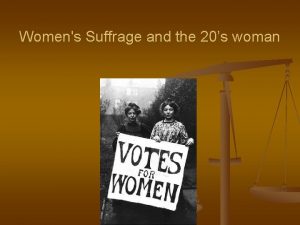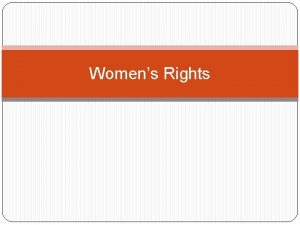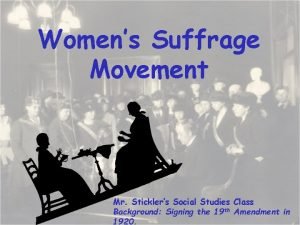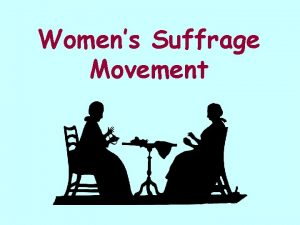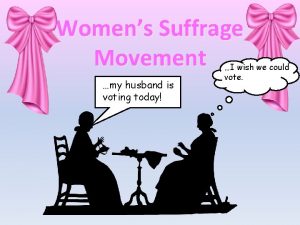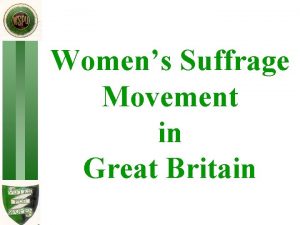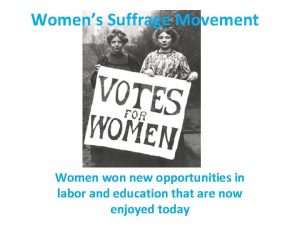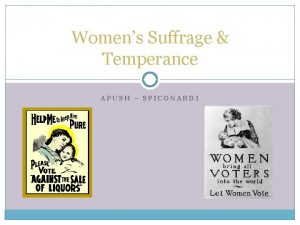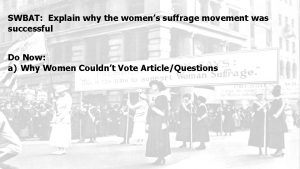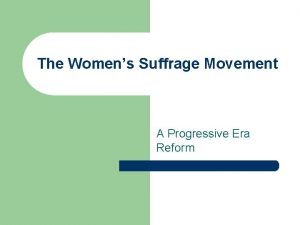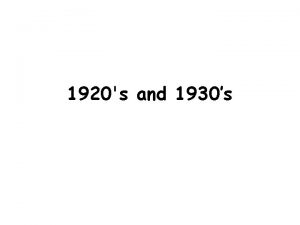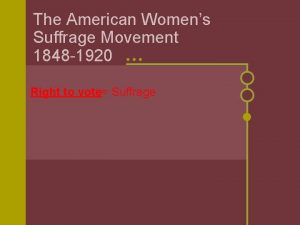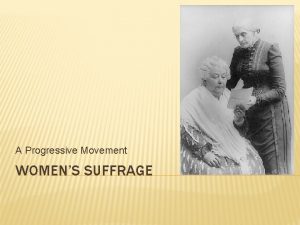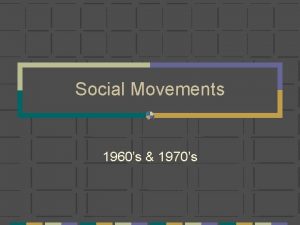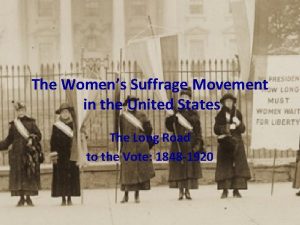Womens Suffrage Movement What does suffrage mean sfrij






































- Slides: 38

Women’s Suffrage Movement

What does suffrage mean? sə-frij, Function: noun Etymology: from Middle English, from Anglo. French, from Medieval Latin suffragium Definition from Latin: vote, political support, from suffragari to support with one's vote

Where did Woman Suffrage begin?

What caused the Women’s Suffrage Movement to begin? • Women fighting for the rights of Black men and fighting against slavery in the Abolitionist Movement

How could fighting for temperance help women?


Why did women want the vote? Card, “Votes for Women to the Rescue. ” Woman’s Journal, 27 April 1912. Courtesy Miriam Y. Holden Collection, Princeton University Libraries.

Lou Rogers, “Breaking into the Human Race. ” Woman’s Journal, 2 December 1911. Courtesy Miriam Y. Holden Collection, Princeton University Libraries.

Mary Ellen Sigsbee, “To the Woman in the Home. ”

Lou Rogers, “Woman’s Place Is at Home. ” New York Call, 1 May 1912. Courtesy State Historical Society of Wisconsin.

Women wanted equality • To be able to attend college • To speak in public without being considered indecent • The right to sign contracts • A wive’s property to remain hers upon marriage Fredrikke S. Palmer, “If The Anti Were Large Enough. ” Woman’s Journal 27 November 1915. Courtesy of Ohio State University Libraries.

They wanted the same rights entitled to men in the Constitution. • Women should be able to own and inherit property • The right to their children if divorced • To be able to serve on a jury • Equal pay for equal work Lou Rogers, “It Makes a Difference Who Says It. ” Woman’s Journal, 22 Feb. 1913.

Who were earliest women leaders for suffrage? • Lucretia Mott • Elizabeth Cady Stanton

Where did the women get their ideas for the Declaration of Sentiments? • We hold these truths to be self evident; that all men are that all men and created equal… women are created equal…

First Suffrage Meeting in Seneca Falls, New York 1848

Susan B. Anthony The Critic and Organizer Born a Quaker Two other causes she fought for: temperance and abolitionism Never married School teacher

Elizabeth Cady Stanton: Writer and Philosopher • Married and mother of 7 • Raised wealthy • Great mind • Created arguments that no man could dispel for 30 years Elizabeth Cady Stanton. 1856. Courtesy Prints and Photographs Division, Library of Congress.

“You stir the pudding while I write. ”

Lincoln’s Emancipation Proclamation freed only the slaves in the South. • Woman Suffrage Movement wanted freedom for all Black men. • Women fought for 13 th Amendment • 400, 000 signatures

13 th Amendment to the Constitution added in 1865 • Abolishes slavery

Why did women oppose the 14 th Amendment to the Constitution ratified in 1868? • Guarantees all male adult citizens the right to vote

15 th Amendment Ratified 1870 • The right of citizens of the United States to vote shall not be denied or abridged by the U. S. or by any state on account of race, color, or previous condition of servitude.

What was the opposition afraid of? National Association Opposed to Woman Suffrage. 1920. Courtesy Prints and Photographs Division, Library of Congress.

Laura Foster, “In the Political Equality Nursery. ” Life, 18 April 1912.

“Two of the Fe’he Males. ” Lithograph. Currier & Ives. Courtesy New-York Historical Society, N. Y. C. .

What were the anti-suffrage arguments? Ida S. Proper, “Anti-Suffrage Parade. ” Woman’s Journal, 21 September 1912. Courtesy Alice Marshall Collection, Camp Hill, PA.

What was the rebuttal? Jessie Banks, “Woman’s Place Is in the Home. ” Woman Voter, October 1915. Courtesy Periodicals Division Library of Congress.

Katherine Milhous, “Votes for Women. ” Postcard c. 1915. Courtesy Alice Marshall Collection, Camp Hill, PA

Lore Rogers, Suffrage Parade, Washington D. C. Courtesy Susanne Mac. Lean Boone.

How did the Suffragettes portray the male voter? Lou Rogers, “He Does the Family Voting” New York Call, 25 October 1911. Courtesy State Historical Society of Wisconsin.

Why is this cartoon entitled “Lost Argument”? Edwina Dumm, “A Lost Argument. ” Columbus Daily Monitor, 16 May 1917. Courtesy Edwina Dumm and the Ohio State University Libraries.

“Not for ourselves alone” • Elizabeth Cady Stanton died on October 6, 1902 • Susan B. Anthony died on March 13, 1906. • Over 50 years of fighting, and 4 states allowed women to vote at their deaths.

Dates when states passed Woman Suffrage • 1890 Wyoming (1869 in Wyoming Territory) • 1893 Colorado • 1896 Utah, Idaho (1870 -1887 in Utah Territory) • 1910 -1918 Washington, California, Oregon, Kansas, Arizona, Nevada, Montana, New York, Michigan, South Dakota, Oklahoma • 1920 19 th Amendment to U. S. Constitution

The Nineteenth Amendment • The right of citizens of the United States to vote shall not be denied or abridged by the United States or by any State on account of sex.


How do the issues of Woman Suffrage play out today?

How are women’s rights being taken away in polygamy?

Source • Sheppard, Alice. Cartooning for Suffrage. University of New Mexico Press, 1994.
 Needs of adolescence
Needs of adolescence Womens rights
Womens rights Late night womens hour
Late night womens hour Claire paine
Claire paine Womens right
Womens right Difference between mens and womens soccer
Difference between mens and womens soccer Womens college kumbakonam
Womens college kumbakonam Womens college kumbakonam
Womens college kumbakonam Womens right
Womens right Womens shelter edmonton
Womens shelter edmonton Women's rights
Women's rights Women anatomy
Women anatomy Womens history month door
Womens history month door Womens community shelters
Womens community shelters Ballybeen womens centre
Ballybeen womens centre Harijah sivakumar
Harijah sivakumar Womens lacrosse helmets
Womens lacrosse helmets Bristol womens voice
Bristol womens voice How do you calculate mean absolute deviation
How do you calculate mean absolute deviation What does mean mean
What does mean mean What does say mean matter mean
What does say mean matter mean Higher history women's suffrage essay
Higher history women's suffrage essay Universal manhood suffrage
Universal manhood suffrage Women suffrage
Women suffrage The fight for women's suffrage readworks answer key
The fight for women's suffrage readworks answer key Universal male suffrage definition
Universal male suffrage definition Women suffrage
Women suffrage Suffrage
Suffrage Higher history women's suffrage essay
Higher history women's suffrage essay What is a non movement area
What is a non movement area Axial dance
Axial dance Population mean from sample mean
Population mean from sample mean Sampling distribution of the mean
Sampling distribution of the mean How to find best point estimate
How to find best point estimate Mean of the sampling distribution of the sample mean
Mean of the sampling distribution of the sample mean Define mean deviation
Define mean deviation A device that does work with only one movement
A device that does work with only one movement Definition of cyclic movement
Definition of cyclic movement How does cyclic movement differ from migration?
How does cyclic movement differ from migration?

